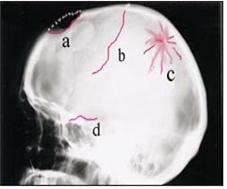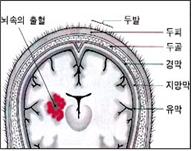두개 강 내 출혈 Intracranial bleeding

사진1-202. 두부 X-선 사진으로 두개골 골절을 진단할 수 있다. Copyright ⓒ 2012 John Sangwon Lee, MD., FAAP

사진1-203. 여러 종류의 두개골 골절. a-함몰 두개골 골절, b-선상 두개골 골절, c-분쇄 두개골 골절, d-두개골 저 골절. ▴ Copyright ⓒ 2012 John Sangwon Lee, MD., FAAP
- 머리를 어디에 세게 부딪치거나 머리가 강타 당할 때, 또는 다른 방법으로 두부(머리) 외상을 입을 때 두개 강 내 출혈이 생길 수 있다.
- 뇌 좌상이 있을 때는 뇌 속의 일부의 혈관이 손상되어 뇌 실질 속에 피가 맺히는 정도로 미세한 뇌출혈이 생길 수 있고,
- 경막외 출혈, 경막하 출혈, 또는 뇌 실질 속 출혈이 생길 수 있고 그로 인해 여러 종류의 두개 강 내 혈종이 두개 강 내에 생길 수 있다.
- 심한 두부 외상이 생기면 뇌진탕만 생길 수 있고 또 뇌 좌상만 생길 수도 있고,
- 뇌진탕과 뇌 좌상이 동시 생길 때 경막 외면과 두개골 내면의 사이에 출혈이 생길 수도 있다. 이런 출혈을 경막외 출혈(硬膜外出血)이라 한다.
- 경막외 출혈로 경막외 공간에 피 덩어리가 생길 수 있다. 이것을 경막외 혈종(硬膜外血腫)이라 한다.
- 경막 내면과 지주막 외면 사이에 있는 공간에 피가 나면 경막하 출혈이라 하고, 거기에 생긴 피 덩어리를 경막하 혈종(硬膜下血腫)이라 하고,
- 지주막하에 생긴 출혈을 지주막하 출혈이라고 한다.
- 뇌 실질 속에 생긴 출혈을 뇌출혈이라도 하고 뇌 실질 속에 생긴 피 덩어리를 뇌 혈종이라고 한다. 이런 여러 종류의 출혈을 통틀어 두개 강 내 출혈이라 한다.
- 이런 두개 강 내 출혈이나 혈종을 적절히 치료하지 않으면 생명이 위험할 수 있다.
- 물론 중뇌 교뇌(뇌교), 연수에도 출혈이 생길 수 있다.
- 심한 두부 외상을 입었을 때는 의료구급대, 병원 응급실, 또는 단골 소아청소년과의 지시에 따라 병원 응급실로 급히 데리고 가 뇌 진탕, 뇌 좌상, 또는 그 외 다른 뇌 외상이나 두개 강 내 출혈이 있나 알아보고 적절한 응급 치료를 받아야 한다.
- 두부 외상을 심하게 입었던 당시 두개 강 내 출혈의 증상 징후가 현저히 나타나지 않아도 1~2일 동안 병원에 입원 관찰 치료를 받아야 하는 것이 보통이다.
- 병원에서 퇴원한 후 집에서 관찰 치료를 하는 중 구토하거나 잠을 계속 자거나, 정신이 혼동되거나, 시력이나 다른 감각 기관에 이상이 있거나, 전신 경련을 하거나 머리가 심하게 아프면 의사의 지시에 따라 병원 응급실로 즉시 다시 데리고 가야 한다.

그림1-204. 뇌 실질 속 출혈. Copyright ⓒ 2012 John Sangwon Lee, MD., FAAP 
그림1-205. 경막외 출혈, 지망막(지주막)하 출혈과 경막하 출혈.Copyright ⓒ 2012 John Sangwon Lee, MD, FAAP
Intracranial bleeding 두개 강 내 출혈

Photo 1-202. A skull fracture can be diagnosed with an X-ray of the head. Copyright ⓒ 2012 John Sangwon Lee, MD., FAAP

Photo 1-203. Several types of skull fractures. a-depressed skull fracture, b-linear skull fracture, c-crushed skull fracture, d-cranial base fracture.
▴ Copyright ⓒ 2012 John Sangwon Lee, MD., FAAP
- Intracranial bleeding can occur when the head is hit hard, when the head is struck, or when a head (head) trauma occurs in another way.
- When there is a brain contusion, some blood vessels in the brain may be damaged, resulting in microscopic cerebral hemorrhage, which causes blood to form in the brain parenchyma.
- Epidural hemorrhage, subdural hemorrhage, or cerebral parenchymal hemorrhage may occur, resulting in several types of intracranial hematomas occurring in the cranial cavity. When severe head trauma occurs, only concussion may occur, and only brain concussion may occur.
- When concussion and concussion occur simultaneously, bleeding may occur between the outer surface of the dura and the inner surface of the skull. This bleeding is called epidural hemorrhage (硬膜外出血).
- Epidural hemorrhage can lead to blood clots in the epidural space. This is called epidural hematoma (硬膜外血腫).
- If blood bleeds in the space between the inner surface of the dura mater and the outer surface of the arachnoid, it is called subdural hemorrhage, and the lump of blood generated there is called a subdural hematoma.
- Subarachnoid hemorrhage is called subarachnoid hemorrhage.
- The hemorrhage in the brain parenchyma is called a cerebral hemorrhage, and a lump of blood in the brain parenchyma is called a brain hematoma. Together, these types of bleeding are called intracranial bleeding.
- These intracranial hemorrhages or hematomas can be life-threatening if not properly treated.
- Of course, bleeding can occur in the midbrain gyobrain (ponegyo) and yeonsu. In case of severe head trauma, follow the instructions of a medical paramedic, hospital emergency room, or regular pediatrics department to promptly take them to the hospital emergency room to see if there is a concussion, brain strain, or other brain trauma or intracranial bleeding, and appropriate emergency treatment.
- Should receive. At the time of severe head trauma, even if the symptoms of intracranial bleeding do not appear remarkable, it is common to be hospitalized for 1 to 2 days for observational treatment.
- If you are vomiting, continue to sleep, confused, have an abnormal vision or other sensory organs, have general convulsions